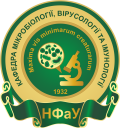Activities of the research laboratory of microbiological and immunological research at the department of microbiology, virology, and immunology.
Achievements in the development of traditional scientific directions
Search research was carried out in a targeted manner to solve the problem of preventing and overcoming antibiotic resistance of pathogens of infectious and purulent-inflammatory diseases. A promising direction is the creation and introduction of a new generation of antimicrobial drugs into clinical medicine, which, according to the inherent mechanism of action on the microbial cell, combines simultaneous effects on various plastic, structural and biochemical characteristics of the pathogen.
Microbiological studies of antioxidant agents used in the complex therapy of infections were conducted. Protection of intracellular structures is carried out by compounds with lipophilic and hydrophilic properties at the same time, in particular α-lipoic acid. Detection of the antimicrobial activity of its medicinal form in the form of thioctic acid requires auxiliary research of the antimicrobial spectrum, level, and mechanism of its antimicrobial action.
To prevent the formation and destruction of biofilms by pathogens of respiratory infections, the properties of mucolytic and expectorant agents in combination with beta-lactam antibiotics were studied.
As part of studying the antimicrobial activity of the drugs Nokamen (Ananta Medicare Limited, India, Canephron (Bionorika, Artznaim), and Urolesan (Arterium, PJSC Kyivmedpreparat) and determining the effect of the drug Nokamen on the level of antimicrobial activity of the Bi-sept (PJSC “Farmak”), Furazolidone (PJSC “Monpharm”), Ciprofloxacin (PJSC “Technolog”, Levofloxacin (“Astrapharm”). It was established that the drugs Nokamen (“Ananta Medicare Limited, India”, Canefron (“Bionorika” Artzneim), and Urolesan (“Arterium”) in vitro showed a weak level of antimicrobial activity against the test strains of S. aureus, E. coli, P. aeruginosa. Preparations Bi-sepT, Furazolidone, Ciprofloxacin, and Levofloxacin in a 1:100 dilution showed a high level of antimicrobial activity. When using Bi-sept, Levofloxacin, Furazolidone, and Ciprofloxacin drugs in combination with the Nokamen drug, no significant difference in the manifestation of antibacterial activity was detected. A tendency to increase the antimicrobial effect was detected by adding the drug “Nokamen” to the drug “Ciprofloxacin” relative to the reference and clinical strains of E. coli.
Non-fermenting gram-negative bacteria of the genus Pseudomonas, presumably phytopathogenic type, were isolated during the study of phytoraw materials. Research is ongoing.
2. New scientific directions
Under the leadership of the head faculty, prof. Filimonova N.I. research work is being conducted to study the degree of antimicrobial activity of anthocyanin complexes of Aronia melanocarpa, Ribes nigrum, and Sambucus nigra on reference cultures Staphylococcus aureus ATCC 25923, Escherichia coli ATCC 25922, Bacillus subtilis ATCC 6633 , Pseudomonas aeruginosa ATCC 27853, Candida albicans NСTC 885-653. Research is ongoing.


